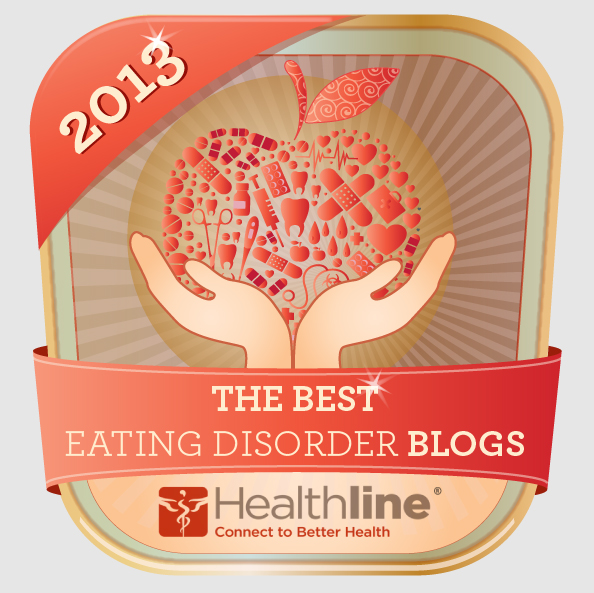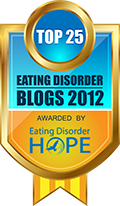Senate Recognizes National Eating Disorders Awareness Week
Surfky
FRANKFORT, KY (3/1/12) – The Kentucky State Senate has recognized that February 26 through March 3, 2012, as National Eating Disorders Week and honored the National Eating Disorders Association on the floor of the Kentucky State Senate.
“Eating disorders are a continually growing problem in Kentucky,” said Jerry P. Rhoads, D-Madisonville. “It is important to raise awareness about this issue so that our citizens will achieve a healthier lifestyle.”
Read Recognizes in full.
Anorexia on the Rise Among Kids and Anti-Obesity Campaigns Blamed
MedicalNet
According to Dr Jane Morris, chairwoman of the Scottish Eating Disorder Interest Group, healthy eating drives are causing anorexia in children. She said children were obsessing about their diet because of drives to combat obesity.
Last week reports of children as young as six were being treated for anorexia emerged, and figures showed medical treatments were on the rise. Dr Morris, a consultant child and adolescent psychiatrist at the Royal Edinburgh hospital, said it was a ‘huge concern.’
Read On The Rise in full.
Anorexia Research Finds Government Intervention Justified
The Guardian
Governments are justified in using the law to prevent modelling agencies from using very skinny women on catwalks and stop magazines from printing adverts and photographs that suggest extreme thinness is attractive, according to research from the LSE.
The first-ever economic analysis of anorexia, studying nearly 3,000 young women in the UK and the rest of Europe, found that the social and cultural environment influences decisions by young women to starve themselves in search of what they perceive to be an ideal body shape.
Young women, who make up 90% of anorexia nervosa cases, are influenced by the size and weight of their peer group.
Anorexia, say the researchers, is a socially transmitted disease and appears to be more common in countries such as France, where women are thinner than the European average. It mostly affects girls and women between the ages of 15 and 34, they found, who were willing to trade off their health against self-image.
Read Justified in full.
Peer Pressure Drives Spread of Anorexia: Study
HealthNews
LONDON (Reuters) - Anorexia is a socially transmitted disorder and appears to be more prevalent in countries such as France where women are thinner than average, according to new research from the London School of Economics and Political Science (LSE).
The "economic analysis" of anorexia, using a sample of nearly 3,000 young women across Europe, concluded that peer group pressure is one of the most significant influences on self-image and the development of anorexia and appeared just as the autumn/winter season is winding up with Paris Fashion Week.
The research by LSE economist Dr Joan Costa-Font and Professor Mireia Jofre-Bonet of City University, showed that it is becoming increasingly apparent that standards of physical appearance are important and powerful motivators of human behavior, especially regarding health and food.
Read Peer Pressure in full.
Research Fail: New Anorexia Study Focuses On Weight, Not Behavior
Blisstree
Anorexia is widely seen as a disease of isolation and loneliness–but according to a new study, it could be a “socially transmitted disease,” passed from one skinny woman to another. Researchers in London have found that body image and weight are greatly impacted by the behaviors, attitudes, and even weights our peers, which is all well and good. Unfortunately, the study has one gigantic flaw that makes it difficult to take seriously: the definition for who is “anorexic” seems to be based solely on weight, not behavior. Which may be how they do it in the DSM, but that doesn’t mean it’s accurate.
Reuters reports that the researchers used a sampling of 2,871 women ranging in age from 15 to 34. The participants reported their age, gender (even though they were all female), marital status, weight, eating habits, political attitudes, education level, and body image perception.
Read Research Fail in full.
Binge Eating is Common Yet Misunderstood
NewsWorks
It's the most common eating disorder, but it often goes undiagnosed or is misdiagnosed. Participants in this week's Binge Eating Disorder conference in Philadelphia want to change that.
Binge eating disorder can easily look like obesity since people who have it tend to be overweight. But it goes far beyond food choices and exercise. Binge eating is triggered by deep psychological distress and eating offers relief -- albeit short-lived.
Chevese Turner said she felt extremely depressed and upset after an eating binge, yet felt unable to stop this behavior which started early on in her life.
Turner was an overweight child experiencing trauma at home and at school, and food became a momentary escape. She said she was able to break the vicious cycle and get better once she understood what she was dealing with, and found a therapist specializing in this disorder
Read Misunderstood in full.
Eating Disorders Quietly Plague Black Communities
The Grio
Although white women were once thought to be the sole group battling eating disorders, over the past few years, reports of eating disorders among minorities -- particularly African-Americans -- have increased.
Stephanie Covington Armstrong, an African-American woman, shares her struggles with bulimia with theGrio.
Raised in Brooklyn, NY, Covington said she grew up poor and dealt with a series of issues that impacted her childhood, including poor eating habits, low self-esteem, and rape. She believes these traumas led to her eating disorder.
"I started thinking that something was wrong with me... that I wasn't lovable... and that I was damaged," she said. "So the way that I was able to kind of calm those fears was with food. My eating would push down all of those fears, and my eating disorder pushed over the edge."
Covington emphasized that the eating disorder gradually took over her entire life.
Read Quietly Plague in full
Weight History May Be Vital to Bulimia Treatment
PsychCentral
In a new study, researchers discovered a majority of women with bulimia nervosa reach their highest-ever body weight after developing their eating disorder — even though bulimia is characterized overall by significant weight loss.
The study concludes that exploring a woman’s weight history and the course of the eating disorder will improve productive discussion of weight and weight history, and thus improve treatments.
Read May Be Vital in full.
Anorexia Loved Me: Victim of Officer's Sex Abuse
smh.com.au
"Anorexia became my friend, it loved me"
"I could not come to terms with what he did to me"
"I have learnt that no one is above the law"
"I now have the power and no one can take that away from me"
A young woman has spoken of her battle with anorexia and depression, which left her "an inch away from death" following the sexual abuse inflicted upon her as a child by a NSW police officer.
The woman fought back tears as she delivered an extended victim impact statement in the sentencing of former Senior Constable Gregory Ernest Urch, 61, who sexually assaulted her and another minor during the mid-1990s.
Read Loved Me in full.
Is Anorexia A Female Disease? Think Again
FairfieldMirror
What do Nicole Richie, Lindsay Lohan, Billy Bob Thorton and Elvis Presley have in common? They have all suffered from eating disorders.
While eating disorders in females are often identified, male celebrities are not publicized as much but they too have fallen victim to the same disease.
In 2008, a student was diagnosed with an eating disorder after witnessing many female schoolmates obsessing over how “fat” they were. Currently receiving treatment four years later at age 14, Avi Sinai is one of many males who have suffered from anorexia nervosa.
According to the National Eating Disorders Association, anorexia nervosa is a “life-threatening eating disorder”, but sex or gender is not mentioned.
Compared to women, men tend to be more secretive about anorexia due to cultural and social expectations within their own society. Thinness amongst women is advertised within the media, allowing them to battle with weight issues without it being socially unacceptable.
Read Think Again in full.
Binge Eating: Patients Struggle to Break Free When Food Takes Control
USA Today
Peterson had been struggling with binge-eating disorder since the mid-'90s, from the time she was just 11. By late 2009, she carried more than 200 pounds on her 5-foot-2-inch frame.
"I was feeling miserable," said Peterson, who works in retail. "I couldn't walk across the parking lot, couldn't run, my back hurt. I felt like my customers thought I was stupid and were judging me."
But her vision kicked her into action, inspiring her to seek help to control her binges and lose weight.
"I lost it, because if I didn't, the binge-eating disorder would have killed me," said Peterson, 29, and more than 70 pounds lighter.
Read Struggle in full.
Anorexia Sees No Age, Color, or Gender
DailyRx
Many people believe that anorexia and bulimia are disorders most apparent amongst white teenage girls, yet a recent report demonstrates that they’re increasingly affecting minorities, children, and boys.
David Rosen, M.D, M.P.H. professor of pediatrics at University of Michigan Medical School, is the author of a new clinical report entitled "Identification and Management of Eating Disorders in Children and Adolescents".
He explains, “the epidemiology of eating disorders has gradually changed.”
He calls upon his fellow pediatricians to “be familiar with early detection and appropriate management of these disorders.”
Read Anorexia Sees No in full.
Eating Disorders Consume the Lives of the Affected
Iowa State Daily
Most people are familiar with the two main types of eating disorders: anorexia and bulimia. Anorexia involves limiting the amount of food one eats while bulimia involves ridding oneself of the eaten food through purging or excessive exercise.
With this week being National Eating Disorder Awareness Week, it is the perfect time for people to become educated about what eating disorders are, who they affect and where to get help.
Eunice Bassler, senior lecturer of food science and human nutrition, explained a common misconception about eating disorders. “Eating disorders are disordered eating patterns with a psychological component.”
Bassler most often deals with disordered eating patterns, which are simply irregular eating patterns. These do not get classified as eating disorders until a psychological condition, such as a distorted view of the body or a fear of gaining weight, is identified along with the disordered eating pattern.
Read Consume in full.
Five Warning Signs of Eating Disorders in Your Teen
TimesUnion
To help attract attention to National Eating Disorders Week (February 26-March 3, 2012), eating disorders and food addictions expert Tennie McCarty offers tips to parents on how to spot eating disorders in their teen children.
“Over the years, most of the talk about eating disorders in teens has focused on anorexia and bulimia, typically blamed on unrealistic body images portrayed in the media. Increasingly however, the discussion has turned to the opposite end of the spectrum - compulsive overeating and food addiction. As the obesity rates in American children continue to skyrocket, teen overeating and addiction to food are becoming serious concerns to many parents,” said McCarty.
Read 5 Warning Signs in full.
Why You Should Care That New Eating Disorders Might Make The DSM-V
BlissTree
When most people hear ‘eating disorder,’ they think anorexia or bulimia. But there are lots of different types of disordered eating—binge eating, compulsive night eating, obsessively health-conscious eating—and psychiatrists may officially recognize several ‘new’ eating disorders in the upcoming Diagnostic and Statistic manual. The DSM guides the way psychiatrists diagnose and treat mental health patients, how insurance companies cover treatment, what researchers get grants for studying and the drugs pharmaceutical companies develop. I asked Dr. Janet Taylor, a clinical psychiatry instructor at Columbia University’s Harlem Hospital, about the DSM, new eating disorders and what these mean for mental health care.
What is the DSM-V?
Read Why You Should Care in full.
May Institute: What Women Over 40 Should Know About Eating Disorders
Wicked Local
It’s not just teenage girls who are willing to starve themselves or “binge and purge” in order to become as thin as the movie stars and fashion models they admire. Today, more and more women in their 40s, 50s, and 60s are seeking help for eating disorders they have developed as they battle slowing metabolisms and thickening waistlines.
"A growing number of older women are developing eating disorders or have hidden them for years," confirms Lauren Solotar, Ph.D., ABPP, May Institute’s Chief Executive Officer and a clinical psychologist who has specialized in the treatment of eating and anxiety disorders.
Read Women Over 40 in full.
Drawing on Experience to Tell Their Eating Disorder Stories
Derby Telegraph
The idea was developed through users of the charity who found it difficult to express how they felt with words.
Lauren Hind, 20, has been using the First Steps programme for the past four years and now volunteers with the organisation.
Her creation involves a picture of her face and words, such as "fat" and "worthless", describing how she has felt.
She said: "When we first had the workshops, I got really angry because I couldn't draw.
"But then the teacher told me that art didn't have to be drawings, it could be words too. Then I came up with my piece. It doesn't have a name. It's all my thoughts and feelings that I've ever had but couldn't say."
Lauren, who lives in Sinfin, used to binge-eat and said she had avoided getting help sooner because she was afraid of being turned away.
Read Drawing On Experience
Healthy Eating Campaigns ‘Causing Anorexia’
Deadline News
A SCOTS expert has said government healthy eating drives are causing anorexia in children.
Dr Jane Morris, chairwoman of the Scottish Eating Disorder Interest Group, said children were obsessing about their diet because of drives to combat obesity.
Last week reports of children as young as six were being treated for anorexia emerged, and figures showed medical treatments were on the rise.
Dr Morris, a consultant child and adolescent psychiatrist at the Royal Edinburgh hospital, said it was a ‘huge concern.’
Read Causing Anorexia in full.
Anorexia and Aging: Is There a Silent Crisis of Eating Disorders in Older Women?
Family Goes Strong
Expert: "Eating disorders are the deadliest mental illnesses and premature death is very common."
It's National Eating Disorders Awareness Week from Feb. 26 – March 3. There is a lot of helpful information available on how younger and younger kids are struggling with eating disorders, how 5-year-old girls are complaining they are "fat," and how boys are now struggling in significant numbers with one of the deadliest mental illnesses there is.
Read Anorexia and Aging in full.



 0
comments
0
comments



















